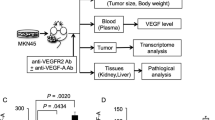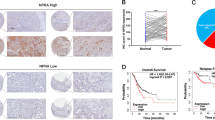Abstract
Angiogenesis is becoming a major target for antitumor therapies, and identifying new angiogenic factors and their specific inhibitors may provide new avenues for tumor management. Here we identify gastrin-releasing peptide (GRP) as a new angiogenic molecule that is secreted by tumors and acts directly upon GRP receptors in the endothelial cells. Addition of GRP increases endothelial cell migration and cord formation in vitro, and induces angiogenesis in an in vivo assay. We have recently identified a small molecule GRP blocker, compound 77427. This inhibitor significantly reduced endothelial cell cord formation in vitro and angiogenesis in vivo. Conversely, when applied to VEGF-induced angiogenesis, the small molecule did not have any effect, demonstrating its specificity. Furthermore, this GRP blocker was able to reduce lung tumor cell growth in vitro as demonstrated by MTT and clonogenic assays. When applied to a xenograft model with lung cancer cells, compound 77427 reduced tumor volume to undetectable sizes, although when the treatment was suspended, tumors began to grow again at normal rates. Our collective observations indicate that GRP is a new angiogenic peptide and that its inhibition offers an attractive tool to reduce tumor burden.
This is a preview of subscription content, access via your institution
Access options
Subscribe to this journal
Receive 50 print issues and online access
$259.00 per year
only $5.18 per issue
Buy this article
- Purchase on Springer Link
- Instant access to full article PDF
Prices may be subject to local taxes which are calculated during checkout







Similar content being viewed by others
References
Busby JE, Shih SJ, Yang JC, Kung HJ and Evans CP . (2003). Angiogenesis, 6, 289–293.
Chaudhry A, Carrasquillo JA, Avis IL, Shuke N, Reynolds JC, Bartholomew R, Larson SM, Cuttitta F, Johnson BE and Mulshine JL . (1999). Clin. Cancer Res., 5, 3385–3393.
Cuttitta F, Carney DN, Mulshine J, Moody TW, Fedorko J, Fischler A and Minna JD . (1985). Nature, 316, 823–826.
Damge C and Hajri A . (1998). Eur. J. Pharmacol., 347, 77–86.
Festuccia C, Angelucci A, Gravina G, Eleuterio E, Vicentini C and Bologna M . (2002). Exp. Cell Res., 280, 1–11.
Garayoa M, Martínez A, Lee S, Pío R, An WG, Neckers L, Trepel J, Montuenga LM, Ryan H, Johnson R, Gassmann M and Cuttitta F . (2000). Mol. Endocrinol., 14, 848–862.
Groger M, Holnthoner W, Maurer D, Lechleitner S, Wolff K, Mayr BB, Lubitz W and Petzelbauer P . (2000). J. Immunol., 165, 5428–5434.
Hayashi S, Ueda M, Amaya F, Matusda T, Tamada Y, Ibata Y and Tanaka M . (2001). Exp. Neurol., 171, 285–292.
Heasley LE . (2001). Oncogene, 20, 1563–1569.
Johnson DE and Georgieff MK . (1989). Am. Rev. Respir. Dis., 140, 1807–1812.
Kiaris H, Schally AV, Sun B, Armatis P and Groot K . (1999). Oncogene, 18, 7168–7173.
Kim S, Hu W, Kelly DR, Hellmich MR, Evers BM and Chung DH . (2002). Ann. Surg., 235, 621–629.
Lango MN, Dyer KF, Lui VW, Gooding WE, Gubish C, Siegfried JM and Grandis JR . (2002). J. Natl. Cancer Inst., 94, 375–383.
Lee JW, Bae SH, Jeong JW, Kim SH and Kim KW . (2004). Exp. Mol. Med., 36, 1–12.
Levine L, Lucci JA, Pazdrak B, Cheng J, Guo Y, Townsend CM and Hellmich MR . (2003). Cancer Res., 63, 3495–3502.
Lockwood CJ, Kumar P, Krikun G, Kadner S, Dubon P, Critchley H and Schatz F . (2004). J. Clin. Endocrinol. Metab., 89, 1467–1475.
Los M and Voest EE . (2001). Semin. Oncol., 28, 93–105.
Lui VW, Thomas SM, Zhang Q, Wentzel AL, Siegfried JM, Li JY and Grandis JR . (2003). Oncogene, 22, 6183–6193.
Mantey SA, Coy DH, Pradhan TK, Igarashi H, Rizo IM, Shen L, Hou W, Hocart SJ and Jensen RT . (2001). J. Biol. Chem., 276, 9219–9229.
Martínez A, Julián M, Bregonzio C, Notari L, Moody TW and Cuttitta F . (2004a). Endocrinology, 145, 3858–3865.
Martínez A, Vos M, Guédez L, Kaur G, Chen Z, Garayoa M, Pío R, Moody T, Stetler-Stevenson WG, Kleinman HK and Cuttitta F . (2002). J. Natl. Cancer Inst., 94, 1226–1237.
Martínez A, Zudaire E, Portal-Núñez S, Guédez L, Libutti SK, Stetler-Stevenson WG and Cuttitta F . (2004b). Cancer Res., 64, 6489–6494.
Michiels C, Arnould T and Remacle J . (1998). Cell Adhes. Commun., 5, 367–374.
Moody TW, Chiles J, Moody E, Sieczkiewicz GJ and Kohn EC . (2003a). Lung Cancer, 39, 279–288.
Moody TW, Leyton J, García-Marín L and Jensen RT . (2003b). Eur. J. Pharmacol., 474, 21–29.
Moody TW, Mantey SA, Pradhan TK, Schumann M, Nakagawa T, Martínez A, Fuselier J, Coy DH and Jensen RT . (2004). J. Biol. Chem., 279, 23580–23589.
Moody TW, Venugopal R, Hu V, Gozes Y, McDermed J and Leban JJ . (1996b). Peptides, 17, 1337–1343.
Moody TW, Zia F, Venugopal R, Fagarasan M, Oie H and Hu V . (1996a). J. Cell Biochem., 24 (Suppl), 247–256.
Nock BA, Nikolopoulou A, Galanis A, Cordopatis P, Waser B, Reubi JC and Maina T . (2005). J. Med. Chem., 48, 100–110.
Ohinata K, Inui A, Asakawa A and Yoshikawa M . (2000). FEBS Lett., 473, 207–211.
Ohinata K, Inui A, Asakawa A and Yoshikawa M . (2001). Peptides, 22, 1809–1816.
Otto M, Bittinger F, Kriegsmann J and Kirkpatrick CJ . (2001). Pathobiology, 69, 159–171.
Safronova O, Nakahama K, Onodera M, Muneta T and Morita I . (2003). Inflamm. Res., 52, 480–486.
Salcedo R, Resau JH, Halverson D, Hudson EA, Dambach M, Powell D, Wasserman K and Oppenheim JJ . (2000). FASEB J., 14, 2055–2064.
Scheurer SB, Raybak JN, Rosli C, Neri D and Elia G . (2004). Proteomics, 4, 1737–1760.
Schuller HM, Jull BA, Sheppard BJ and Plummer HK . (2000). Eur. J. Pharmacol., 393, 265–277.
Shi YH and Fang WG . (2004). World J. Gastroenterol., 10, 1082–1087.
Shimizu K and Oku N . (2004). Biol. Pharm. Bull., 27, 599–605.
Shirahige Y, Cai RZ, Szepeshazi K, Halmos G, Pinski J, Groot K and Schally AV . (1994). Biomed. Pharmacother., 48, 465–472.
Sissons M and Gosney J . (1990). Physiol. Bohemoslov., 39, 305–307.
Soffer SZ, Moore JT, Kim E, Huang J, Yokoi A, Manley C, O’Toole K, Stolar C, Middlesworth W, Yamashiro DJ and Kandel JJ . (2001). J. Pediatr. Surg., 36, 1177–1181.
Vigne P, Feolde E, Van Renterghem C, Breittmayer JP and Frelin C . (1995). Eur. J. Biochem., 233, 414–418.
Wachsberger P, Burd R and Dicker AP . (2003). Clin. Cancer Res., 9, 1957–1971.
Whitley JC, Giraud AS, Mahoney AO, Clarke IJ and Shulkes A . (2000). J. Endocrinol., 166, 649–658.
Acknowledgements
We would like to thank Ms Rita Salloum for her expertise in handling the mice for the DIVAA. Alfredo Martínez is supported by a grant from the Spanish Ministry of Science and Education (BFU2004-02838/BFI).
Author information
Authors and Affiliations
Corresponding author
Rights and permissions
About this article
Cite this article
Martínez, A., Zudaire, E., Julián, M. et al. Gastrin-releasing peptide (GRP) induces angiogenesis and the specific GRP blocker 77427 inhibits tumor growth in vitro and in vivo. Oncogene 24, 4106–4113 (2005). https://doi.org/10.1038/sj.onc.1208581
Received:
Revised:
Accepted:
Published:
Issue Date:
DOI: https://doi.org/10.1038/sj.onc.1208581
Keywords
This article is cited by
-
Novel role of gastrin releasing peptide-mediated signaling in the host response to influenza infection
Mucosal Immunology (2019)
-
Autophagy mediates paracrine regulation of vascular endothelial cells
Laboratory Investigation (2013)
-
Getting a GRP on asthma
Science-Business eXchange (2011)
-
Genetic changes in small cell lung carcinoma
Clinical and Translational Oncology (2008)



